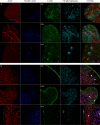Interactions between the flavescence dorée phytoplasma and its insect vector indicate lectin-type adhesion mediated by the adhesin VmpA
- PMID: 34045641
- PMCID: PMC8160148
- DOI: 10.1038/s41598-021-90809-z
Interactions between the flavescence dorée phytoplasma and its insect vector indicate lectin-type adhesion mediated by the adhesin VmpA
Abstract
The flavescence dorée phytoplasma undergoes a propagative cycle in its insect vectors by first interacting with the insect cell surfaces, primarily in the midgut lumen and subsequently in the salivary glands. Adhesion of flavescence dorée phytoplasma to insect cells is mediated by the adhesin VmpA. We hypothesize that VmpA may have lectin-like activity, similar to several adhesins of bacteria that invade the insect gut. We first demonstrated that the luminal surface of the midgut and the basal surface of the salivary gland cells of the natural vector Scaphoideus titanus and those of the experimental vector Euscelidius variegatus were differentially glycosylated. Using ELISA, inhibition and competitive adhesion assays, and protein overlay assays in the Euva-6 insect cell line, we showed that the protein VmpA binds insect proteins in a lectin-like manner. In conclusion, the results of this study indicate that N-acetylglucosamine and mannose present on the surfaces of the midgut and salivary glands serve as recognition sites for the phytoplasma adhesin VmpA.
Conflict of interest statement
The authors declare no competing interests.
Figures







Similar articles
-
A knockdown gene approach identifies an insect vector membrane protein with leucin-rich repeats as one of the receptors for the VmpA adhesin of flavescence dorée phytoplasma.Front Cell Infect Microbiol. 2023 Nov 6;13:1289100. doi: 10.3389/fcimb.2023.1289100. eCollection 2023. Front Cell Infect Microbiol. 2023. PMID: 38029232 Free PMC article.
-
Variable Membrane Protein A of Flavescence Dorée Phytoplasma Binds the Midgut Perimicrovillar Membrane of Euscelidius variegatus and Promotes Adhesion to Its Epithelial Cells.Appl Environ Microbiol. 2018 Apr 2;84(8):e02487-17. doi: 10.1128/AEM.02487-17. Print 2018 Apr 15. Appl Environ Microbiol. 2018. PMID: 29439985 Free PMC article.
-
Flavescence dorée phytoplasma enters insect cells by a clathrin-mediated endocytosis allowing infection of its insect vector.Sci Rep. 2023 Feb 7;13(1):2211. doi: 10.1038/s41598-023-29341-1. Sci Rep. 2023. PMID: 36750707 Free PMC article.
-
Insect vectors of phytoplasmas.Annu Rev Entomol. 2006;51:91-111. doi: 10.1146/annurev.ento.51.110104.151039. Annu Rev Entomol. 2006. PMID: 16332205 Review.
-
Bacterial adhesins, the pathogenic weapons to trick host defense arsenal.Biomed Pharmacother. 2017 Sep;93:763-771. doi: 10.1016/j.biopha.2017.06.102. Epub 2017 Jul 12. Biomed Pharmacother. 2017. PMID: 28709130 Review.
Cited by
-
PhyEffector, the First Algorithm That Identifies Classical and Non-Classical Effectors in Phytoplasmas.Biomimetics (Basel). 2023 Nov 17;8(7):550. doi: 10.3390/biomimetics8070550. Biomimetics (Basel). 2023. PMID: 37999191 Free PMC article.
-
Lectins and polysaccharide EPS I have flow-responsive roles in the attachment and biofilm mechanics of plant pathogenic Ralstonia.PLoS Pathog. 2024 Sep 23;20(9):e1012358. doi: 10.1371/journal.ppat.1012358. eCollection 2024 Sep. PLoS Pathog. 2024. PMID: 39312573 Free PMC article.
-
Multilocus Genotyping of 'Candidatus Phytoplasma Solani' Associated with Grapevine Bois Noir in Iran.Biology (Basel). 2022 May 29;11(6):835. doi: 10.3390/biology11060835. Biology (Basel). 2022. PMID: 35741356 Free PMC article.
-
A knockdown gene approach identifies an insect vector membrane protein with leucin-rich repeats as one of the receptors for the VmpA adhesin of flavescence dorée phytoplasma.Front Cell Infect Microbiol. 2023 Nov 6;13:1289100. doi: 10.3389/fcimb.2023.1289100. eCollection 2023. Front Cell Infect Microbiol. 2023. PMID: 38029232 Free PMC article.
-
The draft genome of 'Candidatus Phytoplasma palmae' strain LY-C2, the phytoplasma associated with coconut lethal yellowing disease, reveals insights into its biological characteristics.World J Microbiol Biotechnol. 2025 Jul 2;41(7):242. doi: 10.1007/s11274-025-04418-3. World J Microbiol Biotechnol. 2025. PMID: 40593240
References
-
- Gasparich GE. Spiroplasmas and phytoplasmas: Microbes associated with plant hosts. Biol. J. Int. Assoc. Biol. Stand. 2010;38:193–203. - PubMed
-
- Caudwell A. Epidemiology and characterization of flavescence-doree (fd) and other grapevine yellows. Agronomie. 1990;10:655–663. doi: 10.1051/agro:19900806. - DOI
Publication types
MeSH terms
Substances
LinkOut - more resources
Full Text Sources
Other Literature Sources

